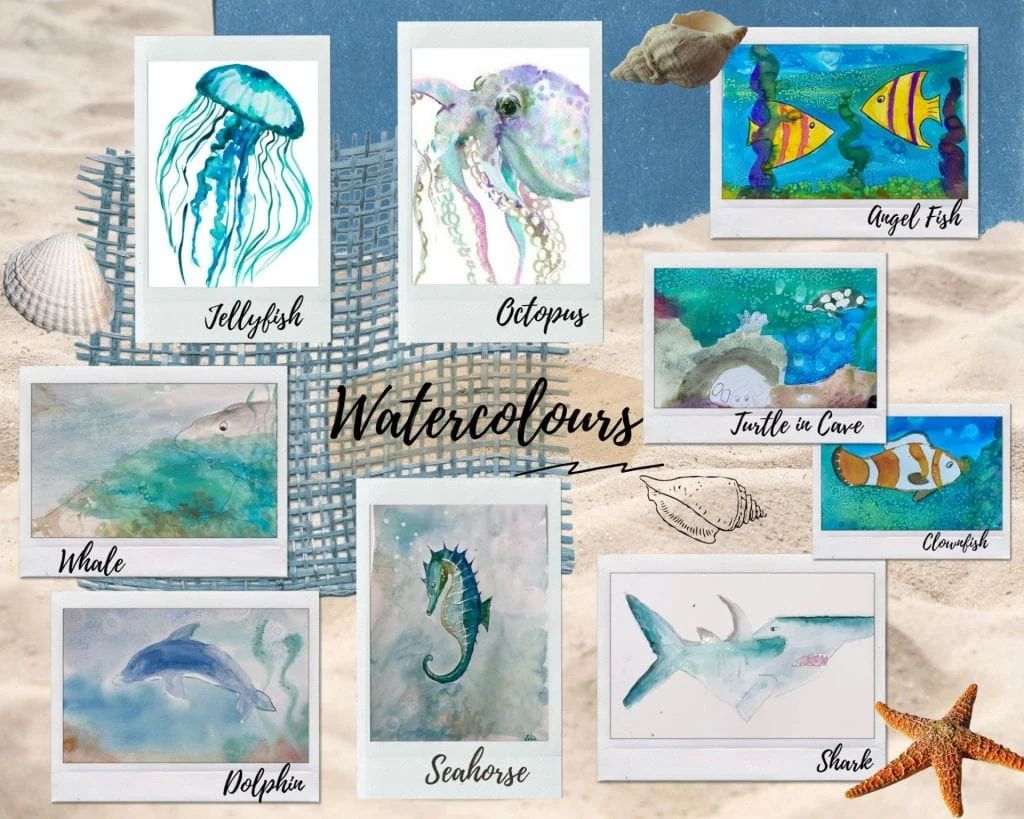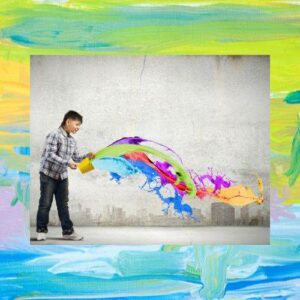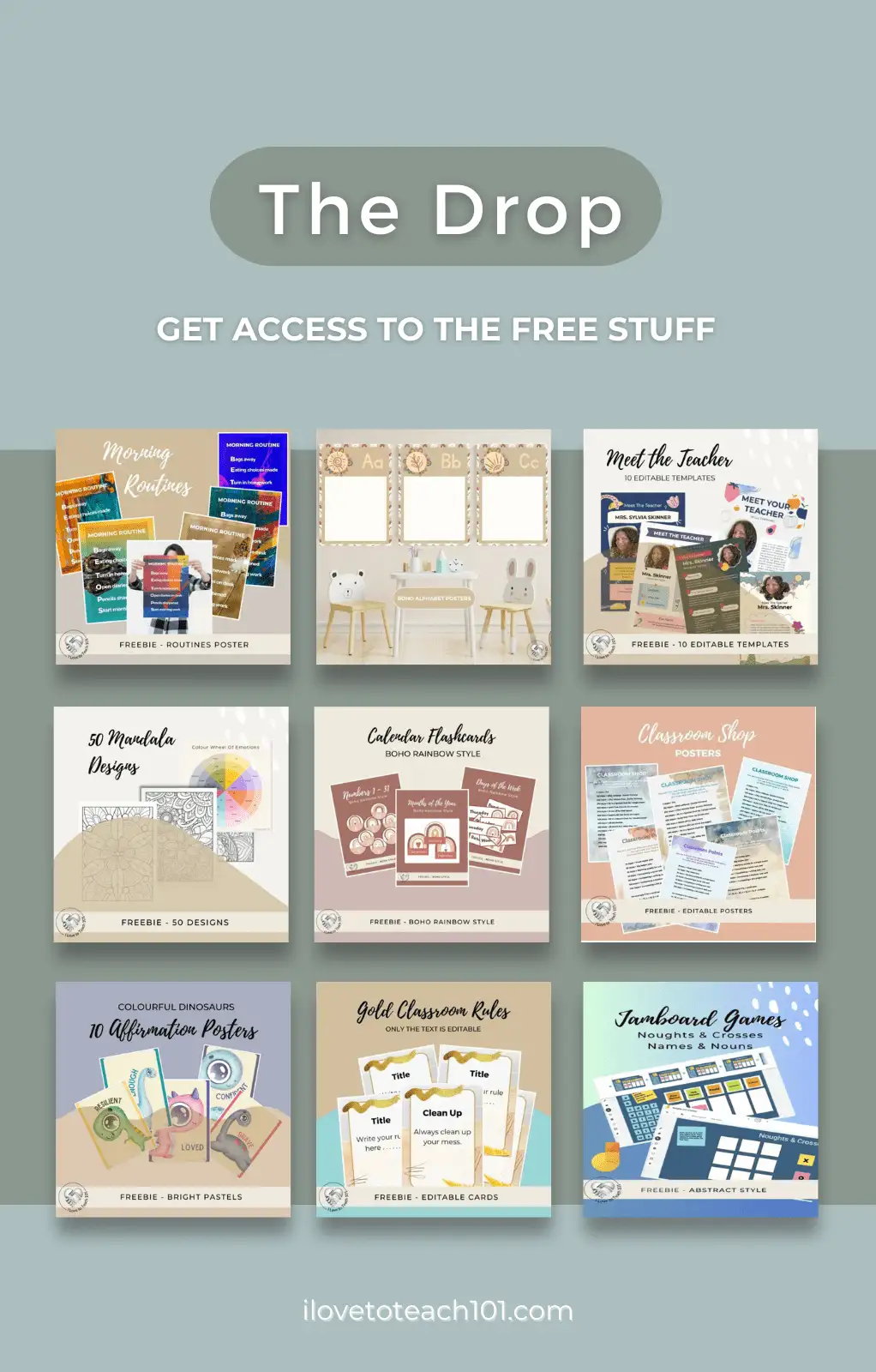- How Can Creative Thinking in Art Inspire Environmental Stewardship?
- How Can Watercolour Techniques Enhance Creative Thinking in Saltwater Environment Themes?
Dive into the dynamic world of watercolours, where each stroke and splash on the canvas isn’t just about creating something pretty. It’s a journey into understanding and appreciating our planet’s precious ecosystems. Particularly, the mesmerising saltwater environments.
In this series on creative teaching in visual arts, I want us to explore different environmental themes that captivate and educate our learners.
So, last term, I had my students embrace the vibrant world beneath the waves, employing a palette of watercolour techniques to sketch, shade, and shape their perceptions of the ocean’s depth.
Experimenting leads to mastery and creative thinking in art
Before diving into their main projects, we kick things off with a bit of an experimental phase. Think of it as a playground for budding artists. By allowing students to first experiment with the wonders of watercolour techniques, we empower them to understand not just the ‘how’ but the ‘why’ behind each brushstroke. This approach moves us away from simply instructing and towards inspiring students to think creatively.
This hands-on experimentation is crucial. It moves us away from a prescriptive teaching method and towards nurturing an environment where students learn through exploration and personal experience. Students don’t just follow instructions, they make informed choices that enhance their creative expressions. Here’s how I introduced these techniques, but you can do it any way you like.
Technique Demonstrations: A Visual Guide
Each class begins with a demonstration of various watercolour techniques, providing a visual and practical guide to the tools available in their creative arsenal. You can see these demonstrations in this short video where I walk them through the techniques.
- Wax Resist: We use a pastel or wax crayon to create areas that repel the watercolour, preserving the whiteness of the paper.
- Wet on Wet: Ideal for creating soft backgrounds or dreamy skies, this technique involves painting on a wet surface to allow colours to blend smoothly.
- Texture with a Sponge: Perfect for adding detailed textures like foliage or coral by dabbing a sponge dipped in paint onto the paper.
- Dry Brush: This technique is all about creating a rough, textured look, great for detailed and rugged features.
- Masking With Tape: We use tape to mask off areas, keeping them free of paint for sharp lines and clean edges.
- Salt on Wet: Sprinkling salt on wet paint creates a star-like or frosty effect, adding a magical texture.
- Rubbing Alcohol: Dropping alcohol onto wet paint creates fascinating textures and effects, perfect for adding a touch of the unexpected.
- Layered Painting: Building up colours in layers adds depth and richness to the painting, each layer enhancing the one below.
- Masking Fluid: Applied to keep certain areas free from paint, this technique ensures parts of the artwork remain untouched.
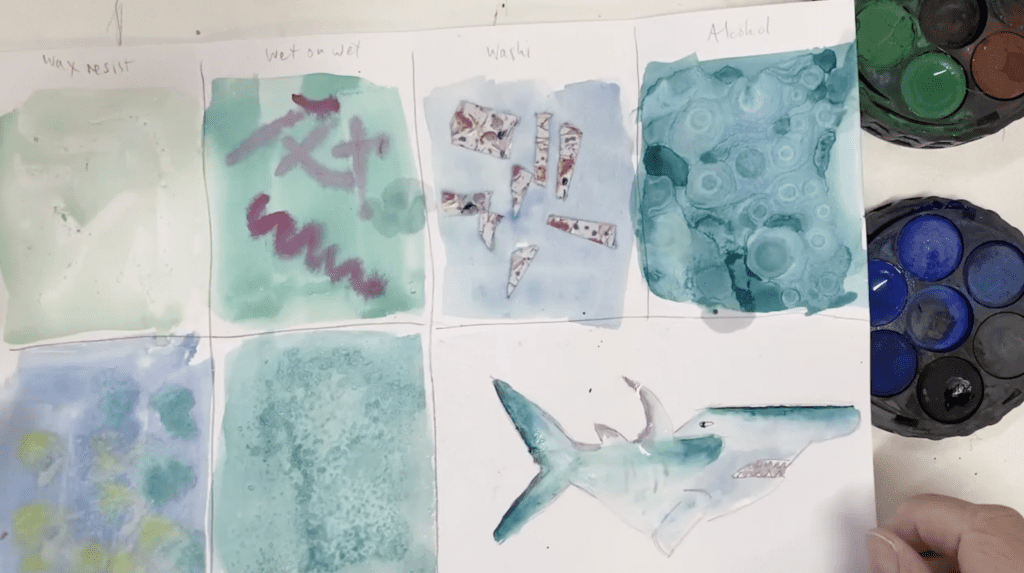
Empowering Students Through Choice and Innovation
After these exploratory sessions, students choose the techniques that resonate most with their creative intentions for their main project. This choice isn’t just about preference, it’s a critical component of creative thinking in art.
They’re encouraged to mix and match techniques to achieve effects that best express their vision of the saltwater themes they’re exploring. This method fosters a deep engagement with their work and builds a strong foundation in creative problem-solving and artistic expression.
By integrating watercolour techniques with the liberty to experiment, we don’t just teach students to paint, we teach them to think creatively, to envision, and to innovate. This empowers them to go beyond the canvas, applying creative thinking to every challenge they may encounter in the future.
But what I love about discovering new ways of making art in a group is that each one of us produces a different piece of art even though we are learning the same technique. I love that. Creativity is definitely personal!
The Significance of Watercolours in Environmental Art
Why watercolour techniques? Their fluidity mirrors the aquatic world, making them the perfect medium to represent the ebb and flow of the ocean’s tides. But there’s more to it than meets the eye.
By integrating watercolour techniques into our art curriculum, we encourage students to experiment and express themselves. We also imbue them with the skills to think critically and creatively about the environment they’re portraying.
This approach goes beyond traditional art education. It’s about encouraging students to become aware of their surroundings and the impact they can have on the world.
Enhancing creative thinking through watercolour techniques
So, how do watercolour techniques specifically enhance creative thinking? They require students to adapt, anticipate, and react. Similar to the skills needed to tackle the challenges posed by environmental issues today.
Each brushstroke can help illustrate the complexities of saltwater habitats, from the texture of coral reefs to the silkiness of a jellyfish’s glide.
Through this artistic exploration, students don’t just learn about art. They learn to analyse and interpret the world around them. Making each painting an exercise in environmental advocacy and creative problem-solving.
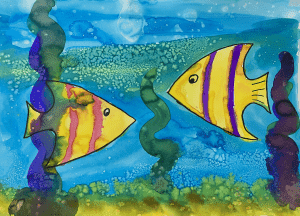
Watercolour Techniques as a teaching tool
When we bring watercolour techniques into the classroom, especially when teaching about the saltwater environment, we’re not just dipping brushes into paint. We’re immersing our students into the depths of the ocean.
Each technique, from wax resist to wet on wet, offers a unique way to engage with art that mimics the natural phenomena found in our seas.
For instance, using salt in watercolour paintings can create patterns that resemble the frothy, bubbly texture of sea foam, while wax resist can be used to depict the glossy bodies of sea creatures like dolphins and sharks.
A guide to implementing a watercolour project
Start by choosing which sea creature each grade will focus on. This specific approach helps tailor the lesson to the developmental stage of each class, making the watercolour techniques more relatable and effective. Here’s a quick breakdown:
- Year 3: Angelfish using salt to create sparkling water effects.
- Year 4: Dolphins, with wax resist to show sleek, wet skins.
- Year 5: Turtles, applying wet on wet to blend green and brown shells seamlessly.
- Year 6: Sharks, using gradients to mimic the ominous depth of their marine habitat.

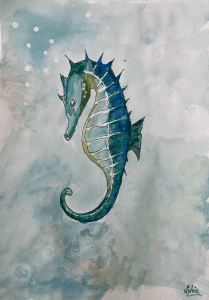
Case Study: Last Term’s Saltwater Environment Project
Last term’s focus on the saltwater environment using watercolour techniques was a splash hit! Students were not just learning how to mix paints. They were learning how to mix their observations with their imaginations.
For instance, Year 7 students explored the majesty of whales using the rubbing alcohol technique to create a mysterious, deep-water effect that echoes the whale’s natural habitat. The result was a series of paintings that celebrated the beauty of marine life and highlighted the fragility of these ecosystems.
The culmination of our watercolour technique explorations was vividly seen in Year 10, where students tackled the intricate art of painting seahorses. This wasn’t just about following a template. It was about challenging each student to think critically about where to add texture, depth, and detail.
Using a combination of watercolour techniques like masking fluid, layers of paint, salt, and rubbing alcohol, students crafted vibrant, textured seahorse paintings.
I filmed a demo, showing each step from the initial sketch to the final touches, providing a roadmap for students. They took this guidance, and moved beyond a paint-by-numbers approach to truly engage with their art.
Linking Art with Environmental Education
Using watercolour techniques to teach about saltwater environments goes beyond creating art, it’s about raising awareness. Each brushstroke is a conversation starter about marine conservation, the impacts of pollution, or the effects of climate change on marine biodiversity.
As educators, our goal is to weave these discussions naturally into our lessons, making the connection between art and real-world issues clear and compelling for our students.
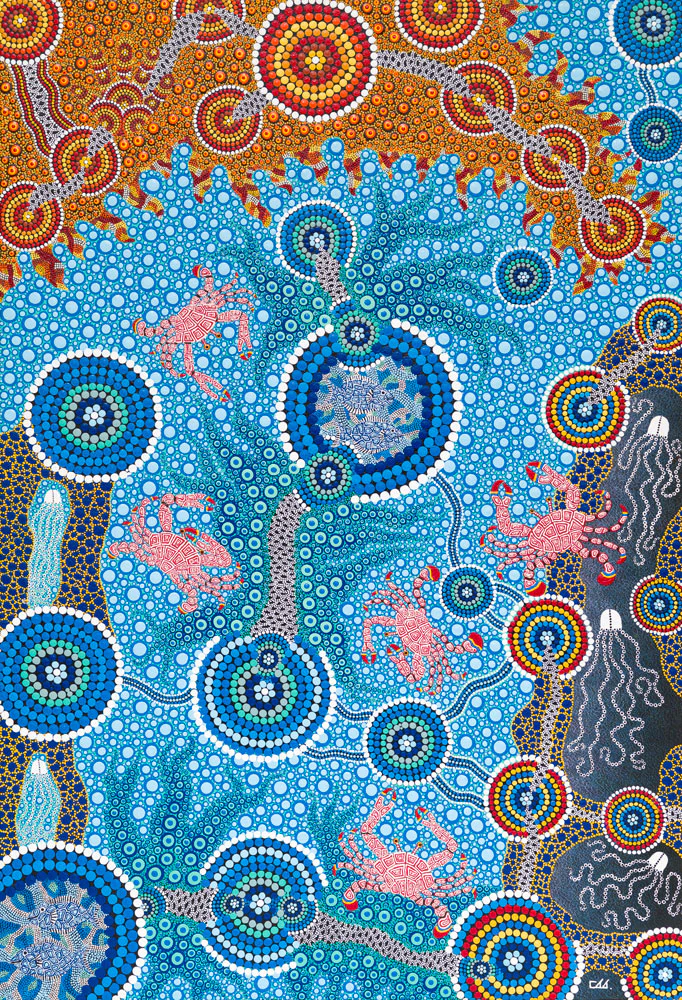
Art Analysis: Integrating Cultural Perspectives
I also had students explore Dot paintings of the Ocean reef by Uncle Tom, an incredible First Nation artist. His vibrant depictions of coral reefs just captivate the senses. Students immersed themselves in it, by reading the stories he tells through his paintings and even tackling quiz questions that pushed them to think deeper about the art and what it represents.
Analysing Uncle Tom’s work is a critical exploration where students respectfully describe his artworks, unpacking the rich cultural narratives and ecological messages embedded within. This isn’t merely about appreciating art for its beauty. It’s about understanding its significance in conveying First Nation perspectives on nature and conservation.
This analysis is a powerful way to blend cultural education with environmental stewardship. It teaches students not just to look but to see, not just to listen but to hear, the stories and struggles, the beauty and urgency of preserving our magnificent planet. This blend of art and cultural insight enriches their learning, making every brushstroke and every discussion a step towards becoming more thoughtful, aware, and responsive citizens of the world.
Unleashing the True Power of Art
We all know the drill, another day, another lesson plan. But it’s not just about filling time. It’s about filling minds and hearts. As busy art teachers, we’re not just teaching watercolour techniques. We’re guiding young minds through a world of colour and expression.
You might be thinking, “How can I squeeze genuine creativity into these packed school days?” Well, you’re doing it, and doing it well, with every stroke and splash that awakens a young artist.
By integrating watercolour techniques into our lessons, we’re not just going through the motions. We’re stirring emotions and curiosity that resonate far beyond the classroom walls.


